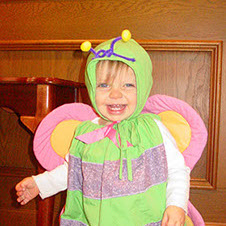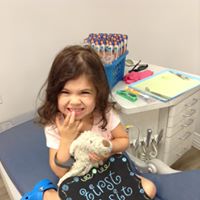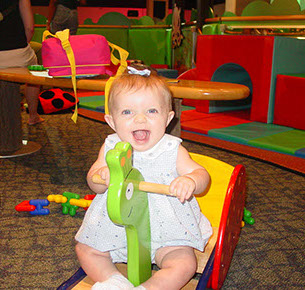Frequently Asked Questions
What Is A Pediatric Dentist?
Pediatric dentists are to dentistry what pediatricians are to medicine. A pediatric dentist has an extra two years of specialized training and is dedicated to the oral health of children from infancy through the teenage years. Much like a pediatrician, a pediatric dentist is carefully trained in all aspects of growth and development. This knowledge gives the specialist an awareness of the specific dental and emotional needs of growing children. The entire focus is on your children; relating to them, fostering good dental health habits and instilling a healthy and positive attitude toward dental visits.
 When Should My Child First See A Pediatric Dentist?
When Should My Child First See A Pediatric Dentist?
If your child goes to bed with a bottle or nurses to go to sleep, we would like to see your child by his/her 1st birthday. If your child does not go to bed with a bottle or nurses to go to sleep, 2 is a good age to take a peek at your child’s teeth to get him or her acquainted with the dentist. We will have your child meet the dental team, see the office and become comfortable in the dental setting. Between ages 3 to 3 1/2 is a great time to have your child’s first check-up; that visit will include a cleaning, fluoride treatment, dental exam and any pictures (x-rays) that might be needed. Our number one goal with your child’s first dental experiences is to create the most positive experience and develop a trusting relationship.
When Will My Baby Start Getting Teeth?
Teething, the process of baby (primary) teeth coming through the gums into the mouth, is as individual as your baby. Some babies get their teeth early and some get them late. In general, the first baby teeth are usually the lower front teeth and usually begin erupting between the age of 4-10 months. All 20 baby teeth usually appear at age 3. The best things to help a teething baby are cold or frozen teething rings or Tylenol (not aspirin) if the pain is very severe. Remember to consult with your child’s pediatrician before giving Tylenol to your child.
When Will My Child Lose Their First Tooth?
Your child has 20 baby teeth. If your child got his/her baby teeth early, then they will loose their baby teeth early and get their permanent teeth early too. If your child got his/her baby teeth late, then they will loose their baby teeth late and get their permanent teeth later too. In general, baby teeth begin getting loose around age 4-6 and permanent teeth begin appearing around age 5-7. The first molars and lower central incisors are usually first to erupt. This process continues until about age 21 or when all 32 teeth (including wisdom teeth) are complete.
Why Are Primary Teeth So Important?
It is very important to maintain the health of the primary (baby) teeth. Neglected cavities can and frequently do lead to problems which affect the developing permanent teeth. Primary teeth are important for (1) proper eating and chewing, (2) providing space for the permanent teeth and guiding them into the correct position, and (3) permitting normal development of the jaw bones and tissues. Primary teeth also affect the development of speech and add to an attractive appearance. While the front 4 teeth last until 5-8 years of age, the back teeth (cuspids and molars) are not replaced by permanent teeth until age 9-14.

What Is The Best Toothbrush And Toothpaste
For My Child?
Tooth brushing and flossing are one of the most important tasks for good oral health. A wet washcloth will work the best for cleaning your baby’s mouth until the first four teeth come in. Just gently massage the gums and teeth in a circular motion with water only. Once more teeth come in, you can use a small, infant size, soft toothbrush and brush in small circular motion. Use children’s toothpaste with a mild flavor and no fluoride until your child can spit. At this time, you can use a fluoride toothpaste, but just the size of small pea. Always use toothpaste that has been approved by the American Dental Association (ADA). Parents should brush their children’s teeth until the child can tie their own shoes (Velcro doesn’t count) at about age 7 or 8. If your child’s teeth touch, then you need to floss in between them, if they don’t touch…don’t floss.
How Do I Prevent Cavities?
Healthy eating habits, good oral hygiene and regular checkups are the best way to have and keep a healthy smile. Children should eat a variety of healthy foods from the 5 basic food groups. Keep sugars and starch snacking to a minimum to cut down on your child’s teeth exposure to sugars. Good oral hygiene removes bacteria and left over food particles that combine together to cause cavities. Remember to brush and floss at least twice a day. Use a soft toothbrush, fluoride toothpaste approved by the American Dental Association and floss in between all teeth that are touching. Children need help brushing and flossing until about the age of seven or eight. The American Dental Association also recommends six-month visits to the dentist. Routine visits will start your child on a lifetime of good dental health.
What Are Sealants?
.jpg?crc=3972615276) A sealant is a clear plastic material that is applied to the chewing surfaces (grooves) of the back teeth (premolars and molars). The sealant acts as a barrier to food, plaque, bacteria and acid protecting the tooth from getting a cavity on the chewing surface of the tooth. Sealants do not protect teeth from getting cavities in between them…only dental floss does this.
A sealant is a clear plastic material that is applied to the chewing surfaces (grooves) of the back teeth (premolars and molars). The sealant acts as a barrier to food, plaque, bacteria and acid protecting the tooth from getting a cavity on the chewing surface of the tooth. Sealants do not protect teeth from getting cavities in between them…only dental floss does this.
What Do I Do When I Have A Dental Emergency?
The first thing to do in any emergency is to remain calm, gather the facts of the emergency and call for help. If your child has KNOCKED OUT A PERMANENT TOOTH, find the tooth and inspect it. If the tooth is sound, try to reinsert it into the socket. Have the child hold it in place by biting on gauze. If you cannot reinsert the tooth, put it in milk or saliva. The child must see the dentist IMMEDIATELY! Time is a critical factor in saving the tooth. If your child has CUT OR BITTEN THEIR TONGUE, LIP OR CHEEK and there is bleeding, apply firm but gentle pressure to the area. If the bleeding does not stop after 15 minutes, take your child to the emergency room. If your child has BROKEN A TOOTH, rinse dirt from the area with warm water, place a cold compress over their face in the area of the injury, save any broken pieces that you can find and go to the dentist IMMEDIATELY.
What About That Finger/Thumb/Pacifier Habit?
Thumb-sucking is a natural reflex, as is finger and pacifier sucking. It may make your child feel happy and/or provide a sense of security. A sucking habit can, however, produce harmful changes in jaw development. How intensely a child sucks will greatly impact whether dental problems result in the future. By stopping the habit now, some self-correction may be possible. If the habit continues, however, additional changes in jaw relationship, teeth and facial appearance may occur. These changes may require some type of orthodontic treatment in the future.
A few suggestions to help your child get through the sucking habit:
Positive Reinforcement - Instead of scolding your child when he/she sucks his/her thumb, praise them when they don’t. Positive reinforcement can be very effective - studies show this technique has the highest rate of success.
Books – There are two books that you can get from the local library - David Decides About Thumbsucking, by Susan Heiter, Ph.D. and Harold’s Hideaway Thumb, by Harriet Sonnenschein – that are very educational and which provide useful techniques aimed at ending thumb sucking.
New Rules – You can make a rule that your child can only suck their thumb/fingers/pacifier while in your home or in their bedroom. If you child can do it anywhere at anytime, there may not be much of a reason to stop. Bitter or Spicy – You can try the bad tasting stuff available at pharmacies. This does work with some children, but only about 10% of the time. Please use caution with this as children may rub their eyes with the irritants. Restraint – Try a Band-Aid or sock on your child’s hand. If his/her fingers are not available, they can’t suck on them.
Appliance – We can make an appliance to help you child break the habit. The appliance is made by our orthodontic lab and is cemented to your child’s upper back teeth. It is relatively successful if your child wants to stop the habit. On the other hand, if your child does not want to stop the habit, don’t waste your money on this, as you child will find a way to suck around the appliance.
Children’s Dentistry That Makes You Smile
